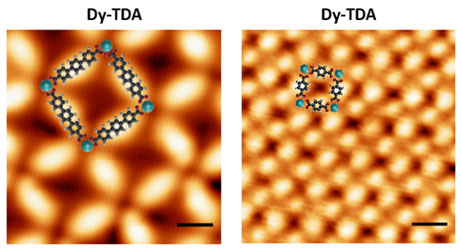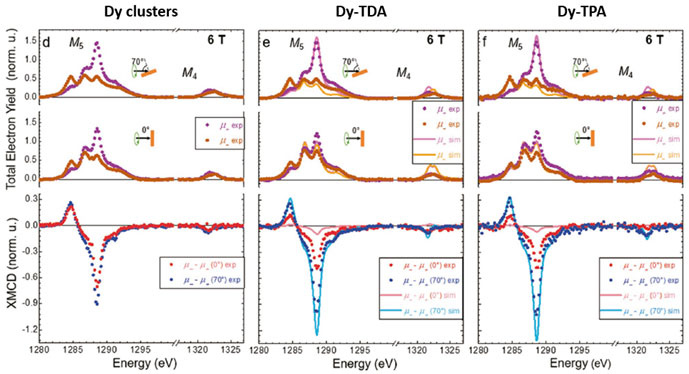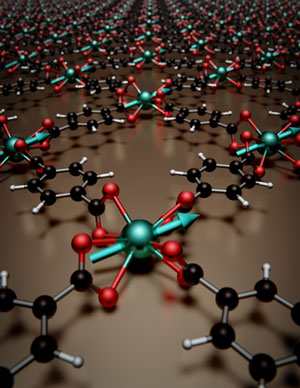|
|
Cerdanyola del Vallès, 11 August 2021. Recent findings have highlighted the potential of lanthanides in single atom magnetism. The stabilization of single atom magnets represents the ultimate limit on the reduction of storage devices. However, single standing atoms adsorbed on surfaces are not suitable for practical applications due to their high diffusion, i.e., low thermal stability. The next step towards more realistic systems is the coordination of these atoms in metal-organic networks. In 4f elements, the spin-orbit coupling (SOC) is larger than the crystal field, which might result in higher anisotropies. Furthermore, the crystal field acts as a perturbation of the SOC and can be tailored to increase the anisotropy by choosing an appropriate coordination environment. The strong localization of the 4f states reduces the hybridization with the surface, increasing the spin lifetimes, which is crucial, since a long magnetic relaxation time is mandatory for technological applications. Figure (left): Cover picture showing the structure of the Dy-TPA network where C, H, O and Dy atoms are represented by black, red and green balls, respectively, the tilted orientation of the magnetic easy axis is represented by green arrows. |
A study performed in collaboration between researchers from IMDEA Nanociencia and BOREAS beamline at the ALBA Synchrotron report the formation of metal-organic networks on Cu(111) based on Dy employing the two carboxylic linkers p-terphenyl-4,4’-dicarboxylic acid (TDA) and benzene-1,4-dicarboxylic acid (TPA), in order to tailor the internodal distance while keeping a similar coordination environment (Fig. 1 a,b). Density functional theory calculations show a metal-organic bond that is predominantly ionic, though a certain degree of covalence between dysprosium and the carboxylate moieties is observed by scanning tunneling spectroscopy.

Figure 1: STM images of Dy-TDA and Dy-TPA networks with atomistic model superimposed. Scale bar: 1.0nm.
Concerning the magnetic properties, isolated Dy atoms on Cu(111) have been recently reported to be almost isotropic, having a very small magnetic anisotropy with an out-of-plane easy axis. However, the intensity of the X-ray Magnetic Circular Dichroism (XMCD) signal of Dy clusters on Cu(111) for grazing incidence is larger than for normal incidence (Fig. 2) revealing a change of the anisotropy axis. Dy-TDA and Dy-TPA networks show a drastic increase of the difference between grazing and normal XMCD intensity of Dy compared to non-coordinated Dy atoms.

Figure 2: XAS and XMCD spectra of Dy clusters, Dy-TDA and Dy-TPA networks on Cu(111) taken at Dy M4,5-edges at normal (0°) and grazing (70°) incidences. For Dy-TDA and Dy-TPA networks multiplet calculations are presented together with the experimental data.
On the other hand, such coordination scheme results in a change of the easy axis of magnetization of the Dy mononuclear center, which upon coordination is aligned nearly parallel to the surface, in opposition to the original out-of-plane easy axis reported for isolated dysprosium atoms on the same Cu(111) surface. The orientation of the magnetic easy axis was determined by a theoretical fitting of the magnetization curves and it is tilted by 73°-65° away from the surface normal (Fig. 3).

Figure 3: Magnetization curves of Dy clusters, Dy-TDA and Dy-TPA networks on Cu(111), experimental data and theoretical fitting, the angle θ indicates the orientation of the magnetization easy axis with respect to the surface normal.
Such findings highlight the complexity of the magnetism of lanthanide systems on surfaces, which can be drastically affected by small structural changes due to molecular coordination and by interaction with the charges of coordination linkers. The magnetic properties are the result of a delicate balance between the interaction of Dy3+ with the negative charges of oxygen atoms and the precise geometry of the CF. This study opens new avenues to tailor the magnetic anisotropy and magnetic moments of lanthanide elements by metal-organic coordination, aiming to develop robust assemblies of single atom magnets.
Reference: Tuning the magnetic anisotropy of lanthanides on a metal substrate by metal-organic coordination S. O. Parreiras, D. Moreno, B. Cirera, M. A. Valbuena, J. I. Urgel, M. Paradinas M. Panighel, F. Ajejas, M. A. Niño, J. M. Gallego, M. Valvidares, P. Gargiani, W. Kuch, J. I. Martínez, A. Mugarza, J. Camarero, R. Miranda, P. Perna, and D. Écija Small 2021, 2102753, DOI: 10.1002/smll.202102753





